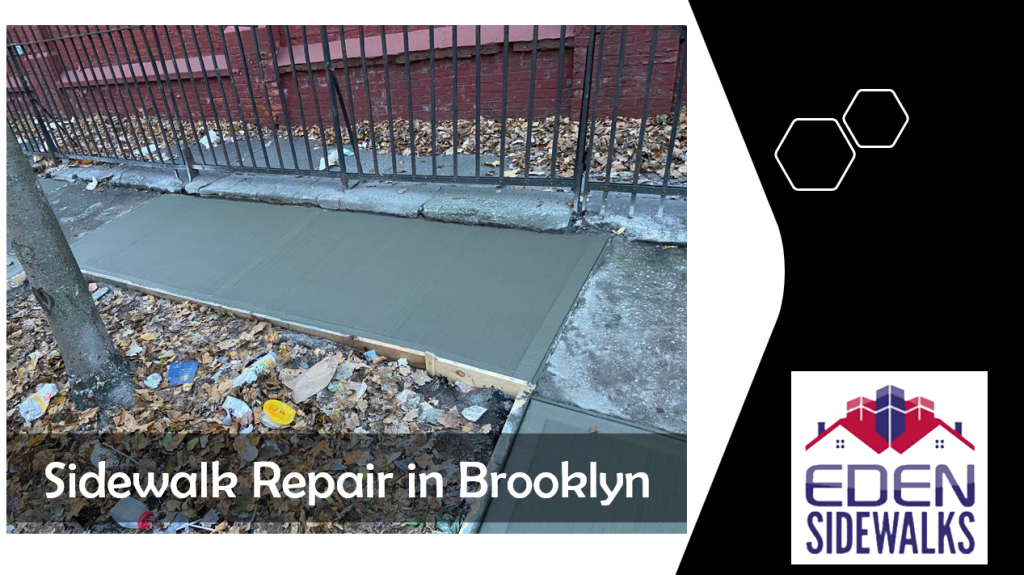Sidewalks are an integral part of any city or town providing pedestrians with a safe and convenient place to walk. In Brooklyn, sidewalks are subject to wear and tear, and eventually, they require repair. There are many different techniques for repairing sidewalks each with its own advantages and disadvantages. In this article, we will discuss the pros and cons of different techniques of sidewalk repair in Brooklyn.
Traditional Concrete Replacement
The traditional method of repairing a sidewalk is to remove the damaged concrete slab and replace it with a new one. This method is time-consuming and costly, but it ensures that the sidewalk is restored to its original state. The process involves breaking up the old concrete and removing it from the site, which can cause disruptions to pedestrian and vehicular traffic. The new concrete is then poured into place and allowed to cure for several days.
Pros:
The new slab is strong and durable, and it can last for many years.
It restores the sidewalk to its original condition, eliminating trip hazards and other safety issues.
It is a long-term solution that requires minimal maintenance.
Cons:
It is expensive and time-consuming.
It can cause disruptions to pedestrian and vehicular traffic during the repair process.
It may not be environmentally friendly due to the amount of waste generated.
Concrete Grinding
Concrete grinding is a popular method of repairing sidewalks that are uneven or have trip hazards. This technique involves using a special machine to grind down the surface of the concrete, making it smoother and more level. The process is quick and relatively inexpensive, and it can be done without disrupting pedestrian traffic.
Pros:
It is a quick and relatively inexpensive method of repairing sidewalks.
It can be done without disrupting pedestrian traffic.
It is effective at removing trip hazards and other safety issues.
Cons:
It does not address the underlying cause of the problem.
It may not be suitable for sidewalks that are severely damaged or have extensive cracks.
It may not be a long-term solution, as the underlying problems may reoccur.
Polyurethane Concrete Lifting
Polyurethane concrete lifting is a newer technique for repairing sidewalks. This method involves injecting a polyurethane foam beneath the damaged concrete slab, which then expands and lifts the slab back into place. The foam hardens quickly, and the sidewalk can be used immediately after the repair is complete.
Asphalt Patching
Asphalt patching is a method of repairing sidewalks that are damaged or have potholes. This technique involves filling the damaged area with asphalt, which is then compacted and allowed to cure.
Pros:
Is a quick and relatively inexpensive method of repairing sidewalks.
Can be done without disrupting pedestrian traffic.
It is effective at filling in potholes and other small areas of damage.
Cons:
May not be suitable for severely damaged or extensively cracked sidewalks.
It may not be a long-term solution, as the underlying problems may reoccur.
May not be as aesthetically pleasing as other repair methods.
Conclusion
There are many different techniques for repairing sidewalks in Brooklyn, each with its own advantages and disadvantages. The traditional method of concrete replacement is a long-term solution that restores the sidewalk to its original state but is expensive and time-consuming. Concrete grinding is a quick and inexpensive method of repairing uneven sidewalks but does not address underlying problems. Polyurethane concrete lifting is a newer technique that is effective at lifting sunken or uneven sidewalks, but it may not be suitable for severely damaged or extensively cracked sidewalks. Asphalt patching is a quick and inexpensive method of repairing small areas of damage but may not be aesthetically pleasing.
When choosing a sidewalk repair technique, it is important to consider the extent of the damage, the cost, and the disruption to pedestrian and vehicular traffic. A professional sidewalk contractors Brooklyn can assess the damage and recommend the best repair technique based on these factors.
In addition to repairing damaged sidewalks, it is important to maintain them to prevent future damage. Regular cleaning and maintenance can help to extend the life of a sidewalk and prevent the need for costly repairs. Sidewalks should also be inspected regularly for cracks and other signs of damage, and repairs should be made promptly to prevent further damage.


